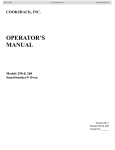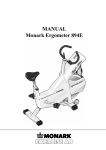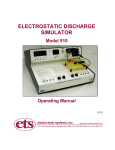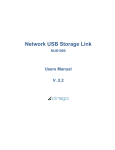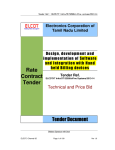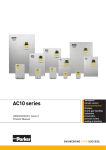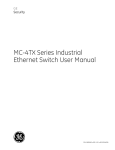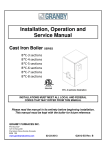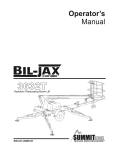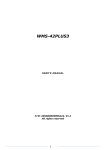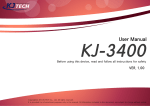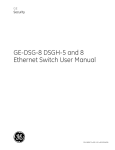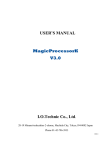Download Caltherm
Transcript
Installation and User Manual for boiler series Caltherm Models CT 35F to 70F 02/2012 v4 2 Thank you for purchasing Caltherm solid fuel boiler. Please read this manual carefully before installation and operation of your product, and keep it during the whole operation life. Do not touch or interfere any part of the product other than those allowed. The installation, maintenance and service of this boiler requires skilled technicians. For the installation of the boiler and proper room selection, installation of water circuit, chimney design, this manual and mandatory regulations must be considered. Caltherm is a welded steel boiler for solid fuel firing which is constructed in three pass horizontal flue gas circulation principle. It is designed for hot water heating systems, should not be used for direct sanitary water supply. Caltherm can hold high amount of fuel thanks to its big volume of combustion chamber. Due to high volume and well contributed size in flue gas passages, and high effecting heating surface, Caltherm boiler fires your fuel with very high water efficiency, saving on your fuel cost. The boiler is constructed with reliable materials at high thicknesses required by related European normative, resulting with long operation life. Caltherm boiler can be used either in forced or natural water circulation systems thanks to its large waterways inside the boiler and medium sized delivery and return connections. You can fire different solid fuels whose specifications are given further in this manual. As calorific values of solid fuel types differ from each other, the output power of the boiler will vary between a maximum and a minimum range specified. Delivery term Caltherm boiler is delivered as fully assembled in one wooden box: 1. Boiler: Fully assembled, doors attached, insulation wrapped, external jackets installed, data label attached. 2. Accessories: Control panel, fan, flue gas retarder, user manual, cleaning brush and fuel shaker arm are delived in the combustion chamber of boiler Optional accessory: A safety heat exchanger kit is delivered upon special request. This kit holds a copper heat exchanger against excessive heat accumulation inside the boiler, a safety valve to activate the heating system at high water temperatures, and auxillary accessories for installation. Whether the hydraulic circuit is open vented or pressurised, this safety heat exchanger system should be utilized within the system for meeting the regulations of related European standard for this product, as well as the safety of whole heating installation and the boiler itself. In case of pressurised hydraulic circuit, the safety heat exchanger kit MUST be installed for safety reasons. Safety warnings Electrical installation of this boiler must be completed in accordance with mandatory regulations, and codes of practice regarding the instructions given in this manual by authorized installator. THIS APPLIANCE MUST BE EARTHED ! Caltherm boiler must be connected to an appropriate chimney whose construction complies with the instructions given further in this manual, and mandatory regulations.The chimney must perform the requested draft values for related boiler model. Your boiler should not be fired unless the chimney connection is made, and there is enough draft for combustion. Any irregular electricity installations in boiler room should be replaced. Always allow enough amount of fresh air in the boiler room. Refer to the instructions for room arrangement. Do not install the boiler in a space, shared or used by people, or in a place with direct openings to a living room. The boiler must be installed in an open vented hydraulic circuit unless the hydraulic circuit is equipped with safety heat exchanger kit according to the directions given further in this manual. Do not feed cold water directly to the boiler overheated by any reason. This may resutl in noise production in the system and/or permanent damage on boiler body. Do not drain water in hydraulic circuit unless in case of maintenance or risk of freezing. Do not fire boiler with front door s open. In case operation with fan, never open front doors without switching the fan off. The system design must provide water flow rates commensurate with boiler output and the temperature difference between flow and return should not exceed 20 C. Water levels should be checked regularly and any leakages corrected in order to keep system water make-up to a minimum, because excessive make-up will lead to salt deposits forming in the boiler waterways causing local overheating and damage to the boiler body. Make sure that your installer applies the recommendations given further in this manual in order to protect either old and new installations from limescale. Particularly, if the boiler is going to be installed in an old heating system, the system should washed away and cleaned from any partıcules before Caltherm is attached Caltherm should be installed directly onto a smooth level floor of non-combustible material. It is recommended that the 3 TECHNICAL DATA 4 Notes for inlet / outlet connections: DG: Dg: Outlet connection To open expansion tank for outlet safety (in case of pressurised system tap this connection) DD: dd: Inlet connection From open expansion tank for inlet safety (in case of pressurised system tap this connection) Never use those pipes for any other installation or purpose. PAGE 3 connection) s connection) 5 INSTALLATION OF HEATING SYSTEM Handling the product Caltherm is a heavy product, and care should be taken when carrying the boiler to the room where it is going to be installed. The total weight of each boiler is indicated in Technical data section. Carrying equipments of product must be of enough capacity to support that weight. Room selection Caltherm boiler must be installed in an individual boiler room particularly organized for heating. The boiler room should be of enough volume for installation, firing, and maintenance of the boiler. There should be enough fresh air circulation for combustion, the chimney design must ensure an dequate draught for related boiler type, and must comply with construction criteria given further in this manual and in mandatory regulations. Your boiler must never be installed in open spaces or balconies, in spaces occupied by people like kitchen, living room, bathroom, bedroom, in spaces where there are explosive and combustible materials. The boiler room should have air ventillation holes through outside to let fresh air in. One air ventillation hole must be built maximum 40 cm below the level of room ceiling, the other must be built maximum 50 cm above the floor level. These ventillation holes should always be kept open. The upper hole should be at least 40x40 cm in size, the lower hole at least 30x30 cm. All hydraulic and electrical circuits must be arranged by authorized staff in accordance with mandatory regulations specified by legal organizations. Solid fuels should be stored by keeping minimum 800 mm distance from the boiler. We recommend you to keep the solid fuel in another room. Caltherm boiler should be installed on a concrete plinth made of a fireproof material. For minimum sizes of the plinth following table should be referred Model Plinth height (mm) Plinth width (mm) Plinth length (mm) CT 35F CT 45F CT 55F CT 70F 50 580 650 640 750 750 900 Clearances around boiler At least the following clearances should be achieved around the boiler Circulation pump We recommend to build a forced water circulation system accompanied with a sufficient pump. To size the pump, refer the boiler water side resistance level given in Technical data section, taking the other resistances created by the hydraulic circuit into account. Refer to the system diagrams given further in this manual to find the right position of the pump wtithin the hydraulic circuit. Your boiler automatically switches the pump on and off according the program stored in its PCB. That is why heating circuit pump must be driven by the control panel. Wiring to the pump is supplied within control panel with indications. So, attach this wire to terminals of the heating circuit pump. The pump will automatically start when boiler outlet water exceeds 40 C., and will automatically swtich off when temperature falls below 40 C. This feature will help prevent boiler from condensation in flue. 6 Rules for hydraulic circuit Open vented hydraulic circuit Caltherm boilers are preferred to be installed in a hydraulic circuit with an open type expansion tank in accordance with the following schemes. The circulation pump may be installed on eitjer delivery or return line of the boiler Open type expansion tank must be installed at the heighest level of whole hydraulic system. No globe valves must be installed on delivery and return safety lines between boiler and expansion tank. Safety lines should be attached to inlet and outlet lines of boiler at points as close as possible to boiler, using the shortest possible vertical way between expansion tank and boiler. If the circulation pump is installed on return line, and the head of pump at maimum speed is "h", the "h" vertical distance given in above scheme must be achieved within the system design (h, being the vertical distance between the top radiator of the circuit and bottom level of open expansion tank). If h is not achieved in such system, there will be air suction on radiators at heighest level of circuit. In this case, the pump must be installed on delivery line from boiler. A hydrometer must be installed on the delivery line to monitor the pressure level and to check if there is any leakage. The hydrometer should be purchased separately, and should be installed at the same level with the boiler outlet. A by-pass line should be installed between inlet and outlet connections of circulation pump in order to allow maximum water delivery when circulation pump is switched off and there is fuel fired in boiler, particularly during sudden electricty cuts off. The optional safety heat exchanger kit is highly recommended to be used with the boiler, even in the case of open vented systems to protect the boiler and the whole heating circuit against excessive heat accumulation. For installation of this kit, please refer to the next section 7 When water temperature in hydraulic circuit is relatively low, particularly when solid fuel is just fired, it is quite normal for water vapour in flue gases to condense. Condensation rarely creates a problem for the boiler, as it will stop when boiler becomes hot. However, the boiler should not be operated in fully condensing mode. When you open loading door, if chamber walls are wet, it means that there is condensation in flue gases. Continuous condensation does not only creates massive sooth on combustion chamber heating surfaces, but also has effect on boiler lifetime. For this reason, we recommend you to set desired boiler outlet temperature not less than 60 C at all times. Design parameters for open expansion tank Expansion tank protects the hydraulic curcuit from excessive temperatures by allowing free volume for expanding water and keeping the water pressure from exceeding the static pressure. Expansion tank may be built in rectangular prism or cylindirical shape, may be installed in horizontal or vertical position in the system. Safety lines between boiler and expansion tank should be installed by an increasing slope up to tank. Following scheme shows the maximum vertical distances between safety lines and boiler: The size of expansion tank can easily be calculated regarding the total expanding water contained in whole system. If the total volume of water in the system is Vs; the volume of expanison tank should be: Vg= 8.Vs / 100 (in liters) In more practical way, just using the nominal heat output of boiler (Qk) in terms of kW, the volume of expansion tank can be caluculated as; SV: Deliver safety line SR: Return safety line Vg= 2,15.Qk (in liters) Sizing safety lines between boiler and open expansion tank Size of the safety line for delivery Size of the safety line for return d SV 15 1,5. Qk d SR 15 Qk (mm) (mm) where Qk is the boiler output in kW. Pressurised hydraulic circuit Caltherm boiler can be installed in a pressurised heating system if following scheme is referred with addition of the safety heat exchanger kit which is supplied as a separate accessory. Safety heat exchanger set includes the following items: 1. Safety heat exchanger (copper serpantine integrated with port for safety valve assembly) 2. Safety valve 3. Flexible hose 2 3 1 To install the safety heat exchanger system: 1. Remove 1 1/2" tap from the safety cooling loop connection at the back of the boiler 1. Install the safety heat exchanger into the 1 1/2" port on upper right hand side at the back of the boiler. After the installation 1/2" female outlet which is going to be used for safety valve installation should be positioned at the top. 2. Install the Regulus JBV-1 safety valve into 1/2" port. 3. Attach the flexible connection hose supplied with the kit between outlet port of safety valve and one of ports of safety valve in respect with the flow direction shown on safety valve body. 8 4. Finally, attach cold water supply line to inlet port of safety valve, amd drain the other port of the safety heat exchanger. If the boiler water temperature exceeds 95 oC, thermostat of the safety valve lets cold sanitary water flows through the serpantine of the safety heat exchanger. Serpantine with cold water circulating inside cools down the boiler water temperature. When the boiler temperature decreases below the safe degree, safety valve shuts the cold sanitary water circulation, and the boiler goes back to normal operation. The valves on the sanitary connections of safety heat exchanger must always be kept open. Caltherm can only be used with origial safety heat exchanger kit which is tested and approved for each boiler model. Cold water must never be delivered directly to boiler inlet in order to solve overheating porblems as this will result in serious damage on boiler body. That application will end the warranty of the boiler. Install a safety valve whose relief pressure is maximum 2,5 bar. Refer to following table when sizing the safety valve: Boiler model: Safety valve size: CT 35F 1/2" CT 45F 1/2" CT 55F 3/4" CT 70F 3/4" Install a manometer and follow the hydraulic circuit pressure. When the boiler is cold, water pressure should be 1 - 1,5 bars. Warning on water level in system After first water make-up in the system, minimum water level must be marked on hydrometer for open vented circuits, minimum water pressure level must be marked on manometer for pressurized circuits. Water level or pressure should be checked daily, and water should added to circuit if they are below the minimum value. Warning on corrosion protection in system Your boiler is quite a strong design against corrosion. However, all metal surfaces in whole heating circuit should be protected against corrosion like piping and radiators. The oxygen in heating water will cause rust and then material loss on iron-based metal surfaces by means of oxidation. 9 During the first water make-up, oxygen must be fully discharged from the system. Generally, oxidation will not be a problem, if all measures are taken into account furing first water make-up. Oxidation will take place because of fresh water addition to the system during operation of the boiler. The main reasons are as follows: 1. In case of open vented systems, oxygen will be added as expansion tank is open to atmosphere. That is why, open expansion tank sizes, its position in the system, safety connections to and from, are very important, and instructions given in this manual for open vented systems should be followed carefully. Pressurized heating system is therefore much more resistant to corrosion. Pressurized system can be preferred, but the optional safety kit against over-heating must be utilized within the system. 2. Leak points in a system will cause oxygen to be absorbed inside the heating water. For this reason, minimum water pressure in a pressurized heating circuit must be above atmospheric pressure. Besides, pressure level should always be checked periodically. Precautions for new installations: System should be sized and designed accordingly, in order to minimize fresh water addition. Make sure that no part of the system is made of material that is permeable to gases. The original system filling water and any topping-up water must always be filtered (using synthetic or metal mesh filters with a filtration rating of no less than 50 microns) to prevent sludge from forming and triggering deposit induced corrosion. Minimum water pressure in a pressurized heating circuit must always be kept above atmospheric pressure Precautions for a new boiler installed in an old system: In old systems used for a long time, a protective coating (black magnetite) has been built on all metal surfaces contact with water. This coating protects the system agains further corrosion. When a mew boiler is installed in such an old system, new parts with clean metal surfaces, particularly boiler surfaces will inevitably become sacrificial anode for the entire heating system, in other words, they come in the first place where corrosion starts. That is why, following precautions should be added to those given above, for a new boiler in an old system: 1. If the old system has an open expension tank, this may be converted to pressurized system with all necessary safety measures. 2. The old system must be fully washed up from all substitutes and particules contained on the surfaces. 3. An air separator with manual vent should be installed at the heighest level of the circuit. Chimney connection Caltherm boiler must be connected to an individual chimney that will provide at least the minimum draught requested. The flue canal between the boiler and the chimney should be insulated using a glass wool material. The flue canal to chimney and chimney must be made of steel or an equivalent material that can be used at temperatures around 400 C All connections on the flue system must be sealed in order to perform a good combustion and efficiency. The flue canal must be connected to the chimney using the shortest way and in accordance with the dimensions given in the following scheme. Horizontal connections and equipments that will increase the pressure loss such as elbows should be avoided A vertical single steel piping should not be used as a chimney. Chimney must be made of one internal and one external surface. External surface may be made of steel or brick. For internal surface stainless steel chimney elements should be preferred against corrosion. The space between internal and external surfaces of the chimney should be insulated to prevent condensation in flue gasses. At the lowest level of chimney, there should be a cleaning cover which is made of steel, and sealed for any leakage. The length of flue canal between the boiler and the chimney should not exceed ¼ height of chimney. 10 The size of flue canal and chimney should not be less than the size of the boiler flue gas outlet connection. For the total height and the minimum internal diameter of the chimney, following diagram should be referred in respect with boiler output power, if otherwise stated in mandatory regulations. The heighest level of chimney outside should be in accordance with the dimensions given in following sketch so as to minimize the harmful effect of flue gasses on ambient, and to improve draught in chimney. LESS THAN 20° 11 ASSEMBLY INSTRUCTIONS Follow the instructions to finish the assembly of boiler accessories supplied together with the boiler 1. Out of the box, your boiler has the configuration as shown on the picture at right hand side 2. First check the condition of flue gas retarder at the 3rd passage of the boiler. If the retarder is not at right position, insert it at the top flue passage as shown in the following picture, draw the retarder backwards fully until it hits the chamber rear wall. 3. Place the flue separator as shown in the following picture at right hand side. Flue separator position is very imprortant as it blocks flue gasses reaching out to chimney without swepping all boiler heating surfaces 4. Fix the front door handles using M8 setscrews supplied with the boiler. 5. Loose the two self tapping screws that fix top panel to rear panel, and take top panel from its housing to continue with installation of control panel and its accessories. Control panel has three sets of wiring for different equipments and sensors. Pass those three wiring sets through corresponding holes cut on the top panel as seen in the following pictures. 12 6. Loose one of self tapping screws that fix left hand side panel to front upper panel, and draw the wiring to the fan, routing it around boiler insulation board, and passing it through the space for fan plug cut on bottom level of left hand side panel. Brown (L) PHASE Blue (N) NEUTRAL YELLOW (E) EARTH 7. Attach isolated terminals of fan wiring to the female plug supplied together with the boiler package. Make sure that you are connecting the right wire to the right terminal on female plug. Follow the matching given in above picture 8. Fix female plug for fan wiring to the left hand side panel by self tapping screw as shown in the following pictures. 9. Fit 4 pieces of M6 x 20 setscrews through the flange holes of fan inlet adaptor on the left hand side. Attach one of seramic paper fan gasket onto those setscrews. Fit fan with position shown in the following picture and secure it with 4 pieces M6 nuts. Attach the male power plug of the fan to the female plug on the left hand side panel: Note: Installation position of the fan is very important, as it has its own air flap integrated on the body. Therefore, follow the instruction above carefully. Fan has also another flap on inlet side to limit air entrance to fan body. Use this flap if you need further air flow control during combustion. Never let this flap positioned fully closed Notes for wiring: Wiring type Identification at the end of the wire To the fan To the pump To the mains To bi-metal safety limiter External burner (pellet) Room thermostat FAN / TO BLOWER FAN POMPA / TO PUMP BESLEME / TO MAINS EMNIYET / SAFETY LIMIT THERMOSTAT TO EXTERNAL BURNER ODA TERMOSTADI / ROOM THERMOSTAT ft hand side. Attach one of g picture and secure it hand side panel: on the body. Therefore, trance to fan body. Use ed fully closed nd of the wire 13 LIMIT THERMOSTAT ROOM THERMOSTAT 14 10. Insert NTC sensor into the pocket between the outlet pipe and connection pipe to safety line to open expansion tank. Attach two ends of wiring to bi-metal thermostat onto the two terminals on the thermostat as seen on right hand side NTC sensor 10. Draw wiring to mains and heating circuit pump through cable clips and secure the cable and clips together on the side panel of the boiler as shown on the following picture. 11. Finally fix control panel to top panel of the boiler with supplied M5 setscrews. Then re-position the top panel into its original place and secure it. Note: If you have a pressurised heating circuit with cloesd expansion tank, tap the two pipes intended to connect to open expansion tank at the inlet and outlet side. Safety heat exchanger (optional) The safety heat exchanger is used to save the boiler in case of overheating. In case of electrical cutout, pump defect etc. the boiler water temperature can be overheated. If the boiler water temperature exceeds 95 ºC, thermostat of the safety valve lets cold sanitary water flows through the serpantine of the safety heat exchanger. Serpantine with cold water circulating inside cools down the boiler water temperature. When the boiler temperature decreases below the safe degree, safety valve shuts the cold sanitary water circulation, and the boiler goes back to normal operation. It is best to purchase the safety kit together with the boiler, and install during the boiler assembly as this will ease the labour for assembly. However, safety kit can also be installed on an old Caltherm boiler in use " Bi-metal safety limiter es intended to connect ectrical cutout, pump e exceeds 95 ºC, safety heat exchanger. en the boiler temperature nd the boiler goes back sembly as this will ease 15 For installation of safety kit refer to following instructions: 1. Install the safety heat exchanger into the 1 1/2" port on upper right hand side at the back of the boiler. After the installation 1/2" which is going to be used for safety valve installation should be positioned at the top. 2. Install the Regulus JBV-1 safety valve into 1/2" port. 3. Attach the flexible connection hose supplied with the kit between outlet port of safety valve and one of ports of safety valve in respect with the flow direction shown on valve body. 4. Finally, attach cold water supply line to inlet port of safety valve, and drain the other port of the safety heat exchanger. Notes on electrical wiring The boiler is fed with 220 V. A regulator must be used in installations where the power supply is below 205 V or above 230 V. Control panel should be connected to a wall plug with an efficient ground system, which is placed not far more than 50 cm. to boiler with a circuit breaker which has at least 3 mm gap between contacts. For this reason, if a new electrical installation is required, 3x1,5 TTR cables must be used. All electrical installations must be carried out by authorized persons in accordance with mandatory regulations and codes of practise. THIS APPLIANCE MUST BE EARTHED ! 16 OPERATING INSTRUCTIONS Pre-firing checks Before the first operation of boiler right after installation, the hydraulic circuit must be ready for operation. To fill an open vented circuit, the valve on start level line from expansion tank is opened, and the circuit is filled with main supply water. During filling the system all valves and accessories on the lines must be checked for leakage. Filling is is stopped, when water from start level line is observed, closing the valve on this line. Right after that,the hydraulic pressure is marked on screen of the hydrometer. This will make re-filling operations during heating season much easier, just feeding the system with fresh water until the hydraulic pressure on screen reaches the pre-marked value. Before every firing make sure that; * Boiler and circuit are filled with water, and the hydraulic pressure is in the required range. * All valves on the line (except by-pass lines and start leve line) are in open position. * There is enough draught in chimney. * There is electricity in front of the control panel inlet. Panel is in STAND-BY mode. To fill a pressurised circuit, feed the fresh water from main supply line using either the filling/drilling tap connection on the boiler rear sectiion, or the feeding line constructed within the circuit. To purge the air contained in the system, use air relief valves on the hydraulic circuit, on the radiators, and also spring pressure relief valve at boiler hot water outlet. Firing Do not turn on the control panel during the ignition period, leave it in STAND-BY mode * Set the Kindling. Place firestarters, crumpled newspaper (3 or 4 sheets balled up fairly tightly) on the grate of the boiler. Place small kindling over the paper or starter. The more dry, small kindling you have - the easier and better the fire will start. Crisscross the kindling so there is plenty of air space in between each piece. Wood that is packed too tight will not burn properly. Set larger wood on top of the kindling, and continue to set larger and larger pieces on top until the fuel exceeds the 1/3 level of the filling chamber. * Ensure that chimney damper is open. Then light the newspaper at the bottom * For air entrance, leave the lower front door open for a while * After first ignition, turn on the control panel by pressing ON/OFF button. Follow the instructions in the next chapter given for control panel. Close the front lower door. * The fire should be well established within approximately 15 minutes, then filling chamber can be loaded completely but check to make sure that the firelighters have not been extinguished. * Keep the fire going always keep a “flame” on your fire - a smoking or smoldering fire is a cold and inefficient fire and also produces pollutants and creosote (tar in the chimney) Never let the boiler water temperature reach high values sharply with leaving control panel switched off. In this case, instant cold water delivey to hot boiler may result in cracks on boiler body due to high thermal energy. Chimney (flue gas) damper Your boiler has fan assisted combustion. Air for combustion is forced to enter the combustion room. As the speed of the fan is controlled and modulated by control panel, the boiler itself adjust the air flow. However, you can use the flap (or Flue damper half open Flue damper open Flue damper closed 17 If flue circulation to chimney is too fast, you can half close the flue gas damper in order to slowdown the combustion. Likewise, you can leave flue gas damper half closed at any time you want to slow combustion, such as at night mode. When fan is switched off by control panel, there is no air entrance to combustion chamber, thanks to auto shut-off air damper inside the fan adaptor on front lower door. CONTROL PANEL installed - USER INTERFACE Control panel has following features: 1. Displays: 1.1. Actual boiler temperature 1.2. Set boiler temperature 1.3. Fan operation mode and speed 1.4. Circulation pump status 1.5. Boiler operation function (manual, auto, ECO, Night-mode) 1.6. Warning and failure indications 1.7. Set parameters in sub-menus 2. Allows adjustment of following parameters in "MENU" mode: 2.1. Boiler set temperature (between 50 to 90 C with 2 C intervals) 2.2. Fan speed in manual mode 2.3. Maximum fan speed in auto mode (if needed) 2.4. Fan safe over-run working time 2.5. Night mode stop and run time re-set (if needed) 3. Controls: 3.1. Boiler temperature according to set value 3.2. Auto operation of CH pump 3.3. Auto operation of pump 3.4. Modulation of fan speed for optimum efficiency (in "FAN AUTO" mode) 3.5. Room thermostat option 3.6. External burner (preferably as pellet burner) ON/OFF control 4. Safety features: 4.1. If boiler temperature reaches up to 100 C for any reason, fan is shut-off, CH pump is kept in operation. Panel warns the user by an audible buzzer alarm. If boiler temperature falls below 95 C again, buzzer alarms switches off, boiler switches back to its normal operation. 4.2. External bi-metal termostat for additional safety which is activated if boiler temperature is over 110 C. This bi-metal thermostat is of manual reset type due to European regulations. 4.3. High current protection fuse, cut outboard on rear panel of the control box. 4.4. All settings are stored in the memory of electronic board even in case of electricty cut-off 5. Energy-saving functions: 5.1. Circulation pump is switched off below boiler temperatures of 40 C. This will also protect the boiler against excessive condensation. 5.2. Fan speed modulation in respect with desired boiler temperature saves energy and fuel. 5.3. ECO mode automatically shifts set boiler temperature down to 50 C and saves fuel 5.4. NIGHT mode keeps the boiler in minimum flame without stopping during the times when there is no need for high temperatures. This will save too much energy and there will no need re-fire the boiler in the morning. STAND-BY MODE: When mains is attached to control panel has following view in STAND-BY mode. OPERATION MODE You can leave boiler control panel in STAND-BY mode during fuel loading in combustion chamber and first ignition. When there is fire in combustion chamber, control panel must be switiched on immediatley. For setting and usage of control panel, please refer to following chapters. 18 Turning on the panel: By presssing "ON/OFF button" for three seconds, control panel is switched on. LCD display is lit and, actual boiler temperature is displayed. During first ignition, you can run the fan in manual mode. By pressing fan manual button, you can set fan speed at minimum level to help the fire become alive in short time. Fan operation mode setting You can set the speed of the fan manually at 5 steps, or you can leave fan in "AUTO" mode, in that case, fan speed is modulated by the electronic board in accordance with boiler set and actual temperature. When control panel is switched on, fan will automatically work in the last mode left. By pressing FAN CONTROL buttons "manual" or "auto" you can select in which mode fan will operate. Fan in manual mode: When this button is pressed, fan will continously work at selected constat speed: If pressed once: Fan will be ON and speed will be minimum Twice 2nd stage Third 3rd stage Four times: 4th stage Five times: Maximum speed Six times: Fan will be OFF again Fan in auto mode: When this button is pressed, other mode is cancelled, and fan starts to operate in modulated mode in respect with boiler outlet temperature by the help of written software. Boiler outlet water temperature setting You can set desired boiler outlet water temperature as follows: 1. Press MENU button once 2. The icon which points the setting parameter will blink 3. You can increase or decrease the desired outlet water temperature by pressing the buttons on right or left side of the MENU button splay is lit and, actual boiler on, you can set fan speed mode, in that case, fan pressing FAN CONTROL d constat speed: s to operate in modulated t water temperature as follows: ting parameter will blink e the desired outlet water ttons on right or left side of the If you press MENU button once again, thermostat setting will be over, and the menu swtiches to the next set parameter sub-menu. Control panel leaves the MENU mode if you wait for 10 seconds without pressing any button, and goes back to normal operation Short-cut for thermostat setting: You can just press (+) or (-) buttons to set the desired boiler outlet water temperature without entering the MENU. Boiler outlet temperature can be set between 50 C to 90 C, with 2 C intervals. Fan maximum speed setting (for FAN AUTO mode only) You can set the maximum speed of the fan if you choose "fan operation mode" as auto as described in the previous page. Control panel allows you to set the maximum speed in fan modulation mode. If you feel the air is too much for your chimney installation and fuel to be loaded, then you may decrease the maximum speed of fan. In this case, fan will be operated between minimum speed and the maximum new speed you set. This feature will help the boiler save on fuel consumption. To re-set the maximum speed of fan: 1. Press MENU button twice 2. The icon which points the setting parameter will blink 3. You can increase or decrease the new maximum speed between 3 and 5 pressing the buttons on right or left side of the MENU button If you press MENU button once again, thermostat setting will be over, and the menu swtiches to the next set parameter sub-menu. Control panel leaves the MENU mode if you wait for 10 seconds without pressing any button, and goes back to normal operation Auto fan switch-off feature When power is turned on by ON/OFF button of control panel, fan will automatically start no matter what the boiler temperature is. Then, fan will be operated according to your adjustments, that is modulated by electronic board between a minimum speed and a maximum default or re-set speed by the user. Fan is automatically switched-off when desired boiler outlet temperature is reached. If boiler outlet temperature falls below 40 C, electronic board keeps on operating fan as long as a pre-set safety time is elapsed. If boiler temperature does not exceed 40 C again during this safety time, then control panel assumes that there is no fuel in combustion chamber, and fan will be swtiched off. After this safety time, if boiler outlet temperature is over 40 C again for any reason, fan will be switched on again. However, we recommend that you should reset the control panel by pressinG ON/OFF button ONCE in that case. Default value for safety time is 45 minutes. But you can re-adjust this safety time between 5 minutes to 90 minutes by 5 minutes intervals. To re-adjust safety time: 1. Press MENU button three times 2. The icon which points the setting parameter will blin 3. You can increase or decrease the new over-run tim between 5 and 90 minutes pressing the buttons on rig or left side of the MENU button 19 hes to the next set parameter ing any button, and goes back iler outlet water described in the de. If you feel the air e maximum speed of eed you set. This feature ng parameter will blink he new maximum speed tons on right or left side of the hes to the next set parameter ing any button, and goes back o matter what the boiler ed by electronic board tomatically switched-off ng as a pre-set safety time control panel assumes that l be switched on again. tton ONCE in that case. 5 minutes to 90 minutes n three times nts the setting parameter will blink r decrease the new over-run time utes pressing the buttons on right 20 Pump control Pump will operate as long as boiler outlet temperature is above 40 C. Pump is always kept switched off when boiler temperature is below 40 C, in order to prevent condensation and save energy. Control panel does not allow re-set on pump start temperature. Night (sleep) mode adjustments You can use night mode if you do not need to warm the radiators and if you will not stop the boiler permanently. Using this feature you can have a small fire bed in combustion chamber, and you do not have to start-up the boiler from the very beginning. In this mode, fan is switced ON and OFF in respect with a pre-set duration so that it will only operate to maintain a minimum flame in the combustion chamber. According to factory set values, when this mode is activated, fan operates 120 seconds, and stops for 20 minutes. You can re-set this time intervals within the MENU. To re-set ON and OFF time intervals: 1. Press MENU button four times 2. The icon which points the setting parameter will blink 3. You can increase or decrease the OFF time between 10 and 40 minutes pressing the buttons on right or left side of the MENU button 1. Press MENU button again 2. The icon which points the setting parameter will blin 3. You can increase or decrease the ON time between 60 and 240 seconds pressing the buttons on right or left side of the MENU button Slowdown the combustion You can slowdown the combustion by: 1. Decreasing set value of boiler outler temperature or switch control panel to ECO mode 2. Closing flue damper on smokehood to half closed or fully closed position (in case low fire bed) You can combine the steps of 1 and 2, or if you do not want to warm your room you can set the control panel to NIGHT mode. ECO mode You can use ECO mode to shift boiler outlet temperature down to 50 C, if you do not need to much heat in your room instead of decreasing set temperature on the menu. If you want to leave ECO mode, and go back to standard operation just press ECO button once again. NIGHT mode If you want to activate NIGHT mode, just press NIGHT mode button on the control panel. When this mode is selected fan is switched to manual mode at the third speed level. As described above, we recommend you to activate this mode specially during night times when you do not need to heat up the radiators. If you want to leave NIGHT mode, and go back to standard operation just press NIGHT button once again. External burner You can install a pellet burner in respect with the information and recommendations given by your authorised re-seller in your territory. Only approved pellet burners for selected Caltherm F boiler models are allowed to use on this boiler. Manufacturer or re-seller do not hold any responsibility caused by improper application of any axternal burner. pt switched off when rol panel does not he boiler permanently. Using start-up the boiler from the nly operate to maintain a ode is activated, fan operates nts the setting parameter will blink r decrease the ON time econds pressing the buttons he MENU button e low fire bed) et the control panel to NIGHT d to much heat in your room once again. When this mode is selected end you to activate this utton once again. n by your authorised re-seller llowed to use on this boiler. any axternal burner. A clear contact to switch pellet burner ON and OFF in respect with desired outlet temperature is supplied within the control panel. The burner will operate according to its own software when switched ON. Pellet burner is installed on lower front door of the boıiler. You do not have to remove the combustion fan which is on the left hand side of the boiler. You can activate pellet burner just by pressing the EXT.BURNER button on the control panel, then the boiler will operate according to pellet fuel. To switch back to operation with wood or coal, just press FAN MANUEL of FAN AUTO buttons. If you fire wood or coal we recommend you to remove pellet burner from the front door to prevent any damage on the burner Safety shut-offs If boiler temperature reaches up to 100 C for any reason, fan is shut-off, CH pump is kept in operation. Panel warns the user by high temperature icon on LCD an audible buzzer alarm. If boiler temperature falls below 95 C again, buzzer alarm switches off, boiler switches back to its normal operation. If boiler temperature reaches 110 C, it means that there is a problem on control panel's PCB or sensors. In that case, an additional bi-metal safet limiter stops the boiler operation for an external safety. This bi-metal thermostat is attached on the boiler hot water outlet pipe, under the top panel of the boiler. If boiler temperature is above 110 C, fan is switched OFF, but pump is kept ON in order to protect the system against very high temperatures. E1 failure code appears on LCD. In this case, we recommend you to call for a service agent to check the control panel and its associated equipments The bi-metal thermostat is of manual reset type, and therefore it must be manually reset right after the problem is solved. Then the control panel is reset by pressing ON/OFF button once. Failure codes and indicators code E1: Bi-metal safety limiter stopped the boiler High temperature warning code E2: NTC sensor fail No fuel warning Turning off the panel Control panel is turned off by pressing ON/OFF button. Never turn off the control panel when there is fire in combustion chamber. Before opening the front door for fuel addition in combustion chamber, we recommend you to switch off the fan by pressing FAN CONTROL button. After closing the front door, switch on the fan again. After each combustion period, before loading combustion chamber and ignition, the control panel must be reset by pressing ON/OFF button. Room thermostat You can install a room thermostat between the short-cut terminals of room thermostat contact outboard the control panel. If you do not use a room thermostat, leave this wire bridge as it is. When requested room temperature by room thermostat is reached: * Fan and pump are switched off * In the meantime, if boiler temperature exceeds 75 C, pump will start and, be in operation until boiler temperature is below 70 C again Warning on fuels Different fuels require different fresh air volumes for combustion. That is why control panel has some features to adapt the fan speed for the fuel types used for boiler. For example, if you use wood logs as a fuel, boiler will require less air than it needs for combustion of black coal and lignite. Fuels must comply with the specifications given in the technical data section. The manufacturer will not be held responsible for the problems due to lack of fuel specifications, use of fuels not suggested for this boiler. Lack of chimney draugt If there is lack on chimney draught or there is no draught at the chimney (such as badly built, uninsulated, blocked etc) you may face combustion problems (no fire, excessive smoke, condensation due to cold flue gasses). In this case, we strictly recommend you to have your chimney controlled by an expert, and fix any irregularity. 21 ture is supplied within the combustion fan which is on URNER button on the control h wood or coal, just press in operation. Panel warns the below 95 C again, buzzer alarms CB or sensors. In that case, -metal thermostat is attached s above 110 C, fan is switched E1 failure code appears on el and its associated equipments. ight after the problem is solved. hen there is fire in combustion mmend you to switch off the he fan again. n, the control l has some features to adapt el, boiler will require less cturer will not be held for this boiler. uilt, uninsulated, blocked etc) lue gasses). In this case, 22 HEALTH AND SAFETY INFORMATION HEALTH AND SAFETY INFORMATION Control of substances hazardous to user health For the type of material and where used in Caltherm boiler refer to the following chart 1. PAINTS: General purpose black undercoat High temperature black coating Powder coating 2. INSULATION AND SEALS Rock-wool insulation board Glass-wool insulation board (aluminum backed) Fibre-glass rope and tape Ceramic-fibre board CFC free polyurethane spray/foam Refractory brick Asbestos products 3. ADHESIVES High temperature adhesive compound Fire cement Gas jointing compound NOT APPLICABLE Boiler body All jackets NOT APPLICABLE Boiler body Front door Front door Rear cleaning cover NOT APPLICABLE NOT APPLICABLE NOT APPLICABLE Front door NOT APPLICABLE NOT APPLICABLE Specific data sheets are available on request from CALDERA for those materials but the following material handling and first aid procedures should in all cases be observed. Paints, sealants, ceramic-fibre boards 1. These materials contain organic solvents and should be used in a well ventillated area away from naked flames. 2. Do not allow to come into contact with the skin, eyes, inhale or swallow. 3. Use barrier cream or gloves to protect the skin, and goggles to protect the eyes from accidental contact. 4. Small quantities can be removed from clothes or skin with a proprietary paint remover or hand cleaning prdouct. 5. If inhaled, remove sufferer into fresh air, if swallowed clean mouth with and drink fresh water but do not induce vomitting. 6. If in the eye, irrigate the eye with clean water and seek medical attention. Sharp edges Care should be taken when handling sheet metal panels that do not have safety or folded edges Lifting boiler body Care should be taken when lifting boiler body as they can weigh up to a few hundred kilograms and CALDERA can confirm the weight of each individual boiler if required Thermal insulation 1. Avoid contact with skin, eyes or inhaling dust. 2. If cutting insulation then do so in a well ventillated area using gloves to protect the hands, goggles to protect the eyes, and a disposable dust mask 3. If a skin reaction or eye irritation is experienced then discontinue working with the material and seek medical advice. Devices under pressure 1. Avoid contact with the parts of heating system under pressure during operation of boiler. These dangerous parts are such that: Boiler body Boiler inlet and outlet lines Safety lines Pressure relief devices installed on heating system 2. Never attempt to drain water from heating system when the boiler is being operated 3. Never feed the boiler directly with cold water to cool it down for any reason, when the boiler is hot. 23 High temperature surfaces Avoid contact with parts and surfaces having high temparutares which will be hazardous for human such as: Boiler front doors Fire door (movable door behind lower front door) Water delivery and return lines (even if isolated), safety lines Smokehood Connection between flue outlet and chimney Circulator pumps, expansion vessels Boiler room 1. Ensure that the boiler room has an easy access to outside in case of danger in heating system 2. Do not leave the solid fuels and auxillary substances (chips, paper etc) to ignite the boiler, with the distance less than 800 mm from the boiler 3. Do not cover the fresh air openings of the boiler room, as it is very important for the combustion Flue gases 1.There could be a little gas release from the front side of the boiler, when the front loading door is opened. Never breathe this gas flow. 2. When adding solid fuel when there is active fire bed inside the combustion chamber, protect your hands and face. If needed wear protective gloves. Firing fuel 1. Do not take the firing fuel out from the combustion chamber while it is still burning 2. Do not try to put the firing fuel off using water or any other liquids. 3. Do not leave the front doors and fire door open when there is fire inside the combustion chamber 4. To slow down or stop the fire, close air inlets, and flue outlets.. 5. Your boiler can only be fired with the solid fuels whose characteristics have been given in Technical data section. Never use any other solid fuel that would be harmfull for boiler section design, any liquid or gaseous fuels. 24 MAINTENANCE AND CLEANING Regular maintenance by qualified staff, strictly in accordance with the manufacturers instructions is essential for the efficient operation of system. Periodic inspections * Check the water level or pressure either in open vented or pressurised systems. The hydrometer must be marked after first filling of the boiler. So water level can be checked regularly. If the water level or pressure is under the level of static pressure or the system set-up, a water make-up is needed. The make-up water should be softened according the local regulations before feeding into the system to prevent corrosion inside the heating circuit and the boiler. * Front doors of the boiler should be checked for properly closing. Fibre-glass ropes must be replaced if necessary. * Check the condition of refractory inside the front door. If it is damaged, you will have higher surface temperatures on front doors. In this case the refractory should be replaced to save energy and prevent further crack. * Check if there is flue gas leakage from the chimney connections of the boiler, and have it fixed if necessary. * Check wiring to control panel, and wiring from control panel to heating circuit pump and fan. * Check gasket in front of the fan * Check gasket behind the rear cleaning cover. * Check primary air inlet diverter behind the fan assembly flange. Remove any deposits which may block the air flow into combustion chamber * Check the heat transfer surfaces of the boiler. The soot formation will change according to fuel type you use, and the combustion air amount. So if you feel that the outlet water temperature can not reach the usual values with the same conditions, heating surfaces therefore should be cleaned Cleaning of boiler Before cleaning the boiler, switch off the control panel and other electrical appliances in boiler room off. Detach the control panel electrical supply from the mains. To clean the boiler: * Remove flue separator behind the upper loading door. * Remove flue gas retarder from 3rd flue gas passage * Clean all heating surfaces using the brush supplied with the boiler. * Clean the air inlet passages of the bottom grate using fule shaker arm. * Collect all soot deposits inside the ash tray and the smokehood. * Remove the disposals. Maintenance Before each heating season we would recommend you to call for the contracted service agent to check the boiler, heating system, electrical connections, and chimney conditions. Do not attempt to carry any maintenance work without getting help from qualified people. Safety heat exchanger *The valves on the sanitary connections of safety heat exchanger must always be kept open. *Caltherm can only be used with origial safety heat exchanger kit which is tested and approved for each boiler model. *Cold water must never be delivered directly to boiler inlet in order to solve overheating porblems as this will result in serious damage on boiler body. That application will end the warranty of the boiler. 25 Model Fuels Output Efficiency Net weight Water content Total heating surface Combustion chamber volume Combustion ch dimensions Height Width Length Fuel loading clearance (upper door) Maximum fuel loading height Flue circulation Draught Temperature control Temperature control range Maximum operating temperature Minimum return temperature Safety system activated at Maximum operating pressure Water flow/return connections (D) Connection for delivery safety line (dg) Connection for return safety line (dd) Safety heat exchanger connection Filling / draining connection Grille design External dimensions Height (H) H1 H2 H3 H4 Width (W1) W2 Length (L1) L2 Flue outlet diameter (C) Electrical supply Power consumption kcal/h % kg lt m2 dm3 mm mm mm mmxmm mm C C C C bar R R R R R mm mm mm mm mm mm mm mm mm mm W CT 35 F CT 45 F 30.000-35.000 40.000-45.000 80 275 80 3,1 105,0 80 315 90 3,6 124,0 475 420 525 420 621 420 x 250 400 Horizontal three pass Fan forced Fan speed modulation by a digital control panel for prima 50 to 90 100 40 (recommended) 95 2,5 1" 1" 1" 1" 1 1/2 " 1/2" Cast iron 1090 840 375 260 245 580 810 930 1030 640 740 180 232 V - 50 Hz 85 85 Fuel type Maximum fuel charge Combustion period at max load Requested fuel parameters kg h 34 Flue gas mass flow g/s 33,0 Fuel type Maximum fuel charge Combustion period at max load Requested fuel parameters kg h 45 Flue gas mass flow g/s 49,5 41 3 to 5 Maximum water content 20% Maximum cross section 10 cm x 10 cm Average calorific value 17.000 - 20.000 kJ/kg 42,4 55 5 to 8 Maximum water content 15% Average size between 30 to 60 mm Average calorific value 26.000 - 30.000 kJ/kg 63,6 CT 55 F CT 70 F 48.000-55.000 60.000-70.000 80 360 108 4,1 134,0 79 410 124 4,9 165,0 450 480 621 480 765 480 X 305 400 Horizontal three pass Fan forced ion by a digital control panel for primary air 50 to 90 100 40 (recommended) 95 2,5 1 1/4" 1 1/4" 1" 1" 1 1/2 " 1/2" Cast iron 1180 930 375 260 245 640 870 1030 1170 740 880 180 232 V - 50 Hz 85 85 50 3 to 5 aximum water content 20% um cross section 10 cm x 10 cm alorific value 17.000 - 20.000 kJ/kg 51,8 67 5 to 8 aximum water content 15% ge size between 30 to 60 mm alorific value 26.000 - 30.000 kJ/kg 77,7 61 66,0 80 99,0


















































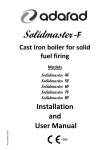
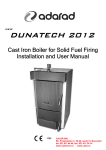
![[AC10] : HA502320U001 : Quickstart Guide to support the Parker](http://vs1.manualzilla.com/store/data/006217721_1-0f90eef9876ce441c4915239f16f04c8-150x150.png)

